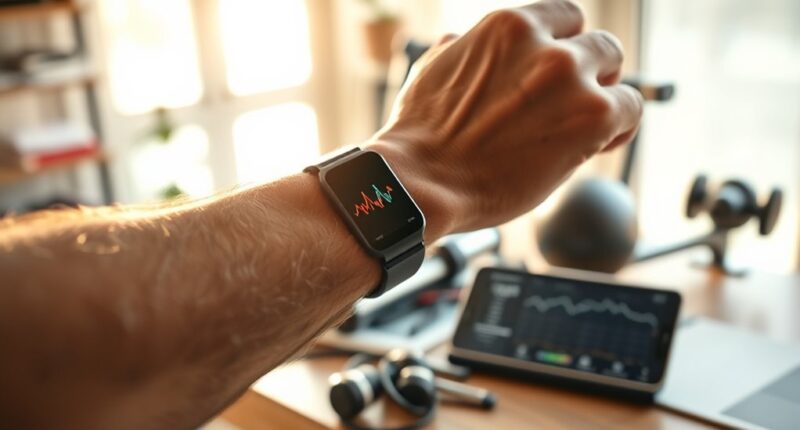Tracking your morning HRV gives you valuable insights into your recovery and stress levels. When you understand your HRV trends, you can adjust your workout intensity, prioritize rest, or push harder, depending on your body’s signals. Consistent measurement with reliable devices helps turn complex data into clear actions, improving your training and reducing injury risk. Keep exploring to learn how to interpret your HRV data effectively for smarter, more personalized decisions every day.
Key Takeaways
- Consistently measure HRV immediately after waking to obtain reliable baseline data unaffected by daily stressors.
- Track HRV trends over multiple days to identify recovery patterns and adjust training intensity accordingly.
- Use stable or rising HRV readings as a green light for increased workout intensity; declining HRV suggests prioritizing recovery.
- Combine HRV data with sleep quality and lifestyle factors to make more informed, personalized training decisions.
- Rely on device accuracy and consistent measurement timing to interpret HRV trends effectively, avoiding misjudgments from single-day fluctuations.
Understanding Heart Rate Variability and Its Significance
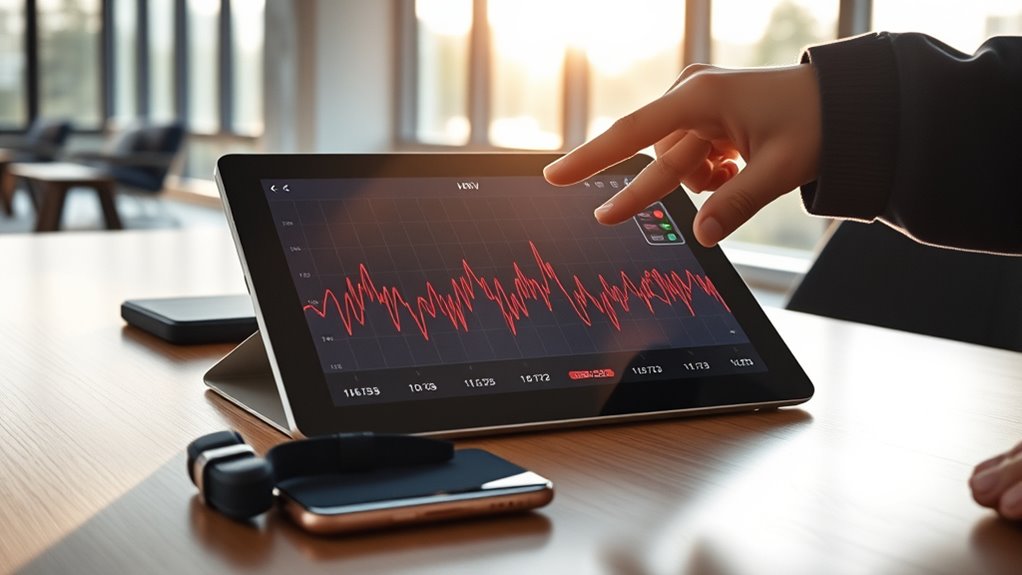
Heart rate variability (HRV) refers to the fluctuations in the time intervals between your heartbeats. Higher HRV often indicates a well-balanced nervous system, which can reflect better overall health. When you practice meditation, you may notice benefits like increased HRV, leading to improved stress resilience and emotional regulation. These benefits also extend to sleep quality, as higher HRV is linked to more restful, restorative sleep. Understanding HRV helps you recognize how your lifestyle choices, including relaxation techniques, influence your body’s recovery capacity. By tracking your HRV, you gain insight into your body’s readiness for training and recovery. Ultimately, a higher HRV signals a healthier autonomic nervous system, making it a valuable marker for overall well-being. autonomic nervous system plays a crucial role in image quality, impacting how well your body perceives details in different lighting conditions and enhancing the clarity of your visual experience.
How to Measure Your Morning HRV Effectively
To measure your morning HRV accurately, pick a consistent time to record it each day. Use a reliable device that provides precise readings, and track your HRV over multiple days to see meaningful trends. This approach helps you get a clear picture of your overall health and recovery. Incorporating AI-driven solutions can further enhance your understanding of your data patterns and optimize your training decisions. Additionally, choosing a vetted device, such as a first home theatre projector, ensures reliability and accuracy in your measurements. Regularly monitoring your autonomic nervous system responses through HRV can give you deeper insights into your stress levels and recovery status, supporting smarter training choices. Monitoring these biometric indicators consistently will help you adapt your routines more effectively.
Consistent Morning Timing
Maintaining a consistent morning timing when measuring your HRV is essential for obtaining accurate and meaningful data. Morning consistency helps control variables like sleep quality and daily stress, ensuring your measurements reflect true changes rather than timing fluctuations. The timing importance lies in capturing your HRV at the same point each day—ideally immediately after waking—so you can track trends over time. By sticking to a regular schedule, you reduce variability caused by different wake-up times or activities beforehand. This consistency allows for more reliable comparisons and better insights into your recovery and readiness. Remember, even slight shifts in measurement time can impact your HRV results, so prioritize a routine that supports stable, comparable data collection. Additionally, understanding the different dog breeds and their characteristics can help tailor your training and care routines more effectively. Incorporating consistent measurement techniques can further enhance the accuracy of your data, providing clearer insights into your health trends over time.
Use Reliable Devices
Choosing the right device is essential for accurately tracking your morning HRV, as unreliable or low-quality tools can lead to inconsistent or misleading data. Select devices with proper calibration to guarantee accuracy over time, and prioritize those that respect data privacy. Reliable devices often sync seamlessly with apps, providing clear insights without compromising your information. Consider whether the device has validated measurements and user reviews.
| Key Feature | Importance |
|---|---|
| Device Calibration | Ensures consistent, accurate readings |
| Data Privacy | Keeps your health info secure |
| Ease of Use | Simplifies daily measurements |
| Compatibility | Works with your smartphone or fitness tools |
| Battery Life | Supports regular morning use |
Track Multiple Days
Tracking your morning HRV over multiple days provides a clearer picture of your overall health and recovery patterns. By observing trends, you can identify how factors like sleep quality and hydration status influence your autonomic nervous system. Consistent measurements help filter out daily fluctuations caused by stress or minor disruptions. Pay attention to changes following nights of poor sleep or dehydration, which often lower HRV. Recording data over several days allows you to see whether your body is recovering well or needs adjustments in training or lifestyle. This broader perspective supports smarter decisions, ensuring you don’t overtrain or push through fatigue. Ultimately, tracking multiple days helps you build a reliable baseline, making it easier to interpret your HRV and optimize your performance and recovery. Additionally, understanding how alimony laws may impact your financial planning can help you make more informed decisions about your health and resources during recovery periods.
Interpreting HRV Trends to Gauge Recovery and Stress
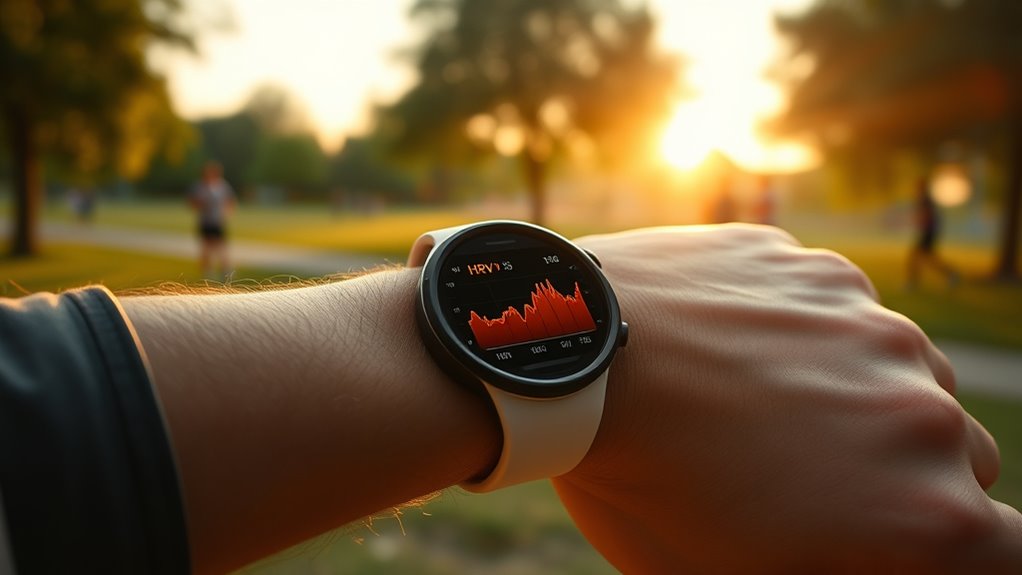
By tracking your HRV trends, you can spot recovery patterns that show how well your body is bouncing back from stress or workouts. Pay attention to signals that indicate increased stress, such as declining HRV levels, so you can adjust your activities accordingly. Recognizing these patterns helps you make smarter decisions about rest and training to optimize your overall well-being.
Recognizing Recovery Patterns
Understanding recovery patterns through HRV trends allows you to identify how well your body is adapting to stress and training. When HRV remains steady or improves over time, it indicates good recovery, often linked to quality sleep and proper hydration. Poor sleep quality can cause HRV to dip, signaling your body isn’t fully recovered. Similarly, dehydration affects your autonomic nervous system, resulting in lower HRV readings. Tracking these patterns helps you recognize when your body is ready for more intense workouts or needs rest. Consistent decreases in HRV may point to inadequate recovery, while stable or rising trends suggest you’re on the right track. By paying attention to these signals, you can optimize training loads and make smarter recovery decisions.
Identifying Stress Signals
Recognizing stress signals through HRV trends helps you determine whether your body is recovering properly or under strain. A decreasing HRV often indicates heightened stress or poor sleep quality, while stable or rising HRV suggests resilience and recovery. By tracking these patterns, you can assess your emotional resilience and adapt your training accordingly.
| HRV Trend | Possible Cause | Recommended Action |
|---|---|---|
| Declining HRV | Elevated stress, fatigue, poor sleep | Prioritize rest, improve sleep quality |
| Stable HRV | Balanced stress and recovery | Maintain current routine |
| Rising HRV | Effective recovery, resilience | Gradually increase training intensity |
Identifying Optimal Training Windows Based on HRV Data
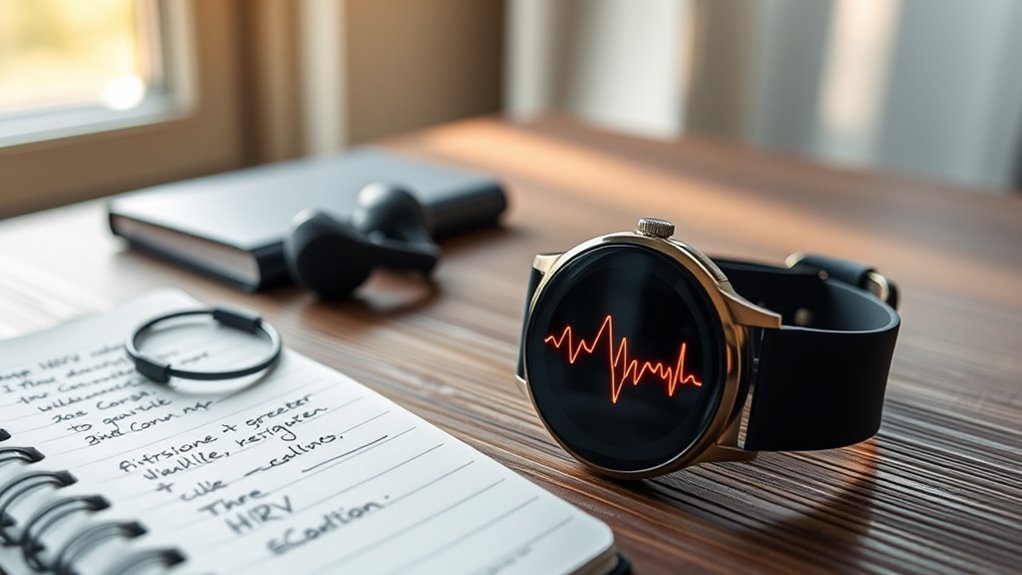
Monitoring your heart rate variability (HRV) allows you to pinpoint the best times to train for maximum effectiveness. When your HRV is high, it indicates your body is well-recovered and ready for intense workouts. Conversely, lower HRV suggests you should prioritize recovery or lighter activity. To optimize your training windows, pay attention to your sleep quality, as good rest boosts HRV and overall readiness. Incorporating breathing techniques, like diaphragmatic breathing, can help improve HRV overnight, signaling better recovery. Tracking these patterns helps you identify days when your HRV peaks, making them ideal for challenging sessions. By aligning your workouts with your HRV data, you maximize performance and reduce injury risk, ensuring you train smarter, not just harder.
Adjusting Workout Intensity Using HRV Insights
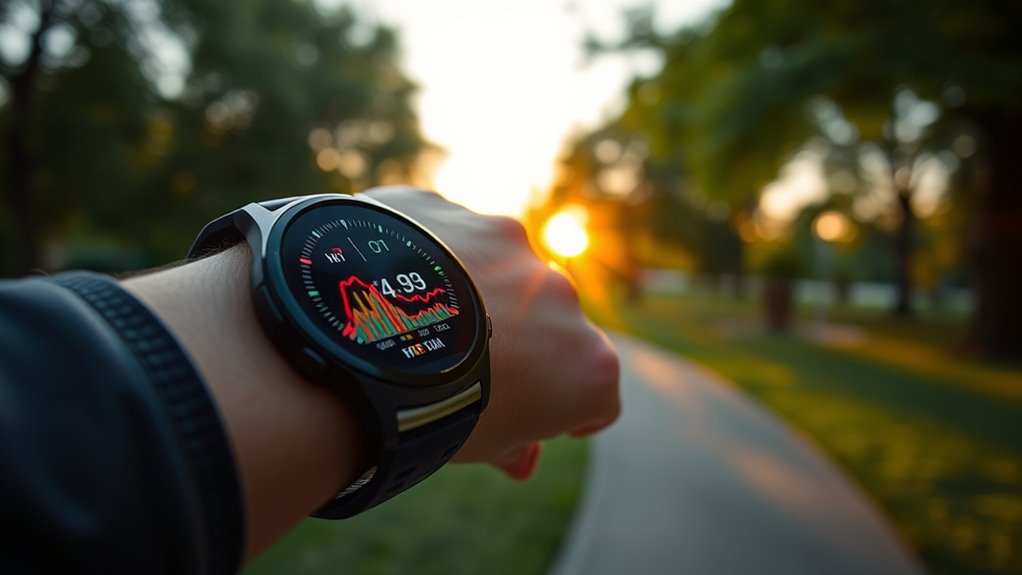
When your HRV data indicates you’re well-recovered and your body’s ready for effort, you can confidently adjust your workout intensity to match your current state. Good sleep quality plays a vital role in maintaining high HRV, signaling that your nervous system is primed. If your HRV is high and sleep was restful, consider increasing workout intensity or trying more challenging exercises. Hydration levels also influence HRV; staying well-hydrated supports ideal recovery and performance. Conversely, if your HRV is lower and sleep quality was poor, scale back your effort to prevent overtraining and allow your body to recover. Listening to these signals helps you tailor your workouts, ensuring you train smarter rather than harder, and reduce the risk of injury or burnout.
Common Pitfalls and How to Avoid Misreading HRV Data
Misreading HRV data can lead to poor training decisions if you’re not careful. One common pitfall is misinterpretation errors, which happen when you draw conclusions without considering context or natural fluctuations. Don’t assume a low HRV always signals fatigue; it could be influenced by stress, sleep quality, or hydration. Device inconsistencies also pose a challenge—different devices or apps may record slightly different readings, making it easy to misjudge your recovery status. To avoid these issues, track HRV consistently at the same time each morning and use the same device whenever possible. Focus on trends over time rather than single-day numbers. Being aware of these pitfalls helps you interpret your data more accurately and make smarter training decisions.
Incorporating HRV Tracking Into Your Regular Training Routine

Integrating HRV tracking into your regular training routine can substantially enhance your ability to optimize workouts and recovery. By monitoring your HRV each morning, you gain insights into how sleep quality and nutritional impact influence your readiness. For example, a decline in HRV might indicate poor sleep or insufficient nutrients, signaling you should adjust your workout intensity or prioritize recovery. Consistent tracking helps you identify patterns, so you can proactively modify your diet or sleep habits to improve overall resilience. Incorporating this data into your routine guarantees you’re training smarter, not harder, and reduces the risk of overtraining. Over time, these small adjustments can lead to better performance, faster recovery, and a more personalized approach to fitness.
Leveraging Technology for Accurate and Convenient HRV Monitoring

Utilizing advanced technology makes HRV monitoring more accurate and convenient than ever before. Wearable devices and smartphone apps now offer real-time insights, simplifying data collection. To maximize accuracy, focus on:
- Using reliable sensors that track HRV during your morning routine.
- Integrating sleep hygiene practices, since quality sleep impacts HRV readings.
- Incorporating nutrition tips, like staying hydrated and avoiding heavy meals before bedtime, to improve overall data consistency.
These tools allow you to quickly assess your recovery and stress levels without cumbersome equipment. By combining technology with good sleep hygiene and proper nutrition, you gain a clearer picture of your health, empowering smarter training decisions. This seamless approach helps you stay consistent and avoid unnecessary fatigue or injury.
Frequently Asked Questions
Can HRV Be Affected by Factors Other Than Training and Recovery?
Yes, HRV can be affected by factors beyond training and recovery. Stress influence plays a significant role, as high stress levels can lower HRV, indicating a stressed state. Sleep quality also impacts HRV; poor sleep can reduce variability, suggesting your body isn’t fully rested. These factors, combined with hydration, illness, or even caffeine intake, can all influence HRV readings, making it essential to take into account them when interpreting your data.
How Often Should I Track My HRV for Optimal Training Adjustments?
For ideal training adjustments, you should track your HRV regularly, ideally daily. This measurement frequency helps you identify trends and fluctuations, allowing you to make informed decisions about your workouts. The optimal timing is in the morning, right after waking up, when your body is most rested. Consistent morning measurements give you the clearest picture of your recovery status and readiness, ensuring your training plan stays effective and safe.
Is There a Recommended Time of Day to Measure HRV for Consistency?
Imagine catching the sunrise, the sky’s quiet glow, and you’re measuring your HRV then. That’s because measurement timing matters for daily consistency. You’ll get the most reliable data if you track your HRV at the same time each morning, ideally shortly after waking. This routine minimizes fluctuations, giving you clearer insights for smarter training decisions. Consistency in timing helps you recognize true trends, not just daily noise.
Can HRV Data Predict Overtraining Before Symptoms Appear?
You might wonder if HRV data can predict overtraining before symptoms show up. It can help with early detection of overtraining signs, allowing you to adjust your training before fatigue or injury occur. By monitoring HRV regularly, you notice declines that indicate your body’s stress levels are rising. This proactive approach helps prevent overtraining, keeping you healthier and more consistent in your performance.
What Are the Best Apps or Devices for Accurate HRV Tracking?
Think of finding the perfect HRV tracker as searching for a needle in a haystack. For accuracy, consider devices like the Whoop Strap or Garmin Vivosmart, which are top wearable devices. Pair them with reliable smartphone apps such as Elite HRV or HRV4Training. These tools help you get precise readings, so you can make smarter training decisions and optimize your performance every day.
Conclusion
By tuning into your morning HRV, you’re revealing a secret map to your body’s rhythm—guiding your training with the gentle whisper of your heart’s signals. When you listen closely, each data point becomes a stepping stone toward smarter, more personalized fitness. Embrace this rhythm, and watch your progress unfold like a sunrise—bright, steady, and full of potential. Your heart’s quiet voice holds the key; all you have to do is listen.
